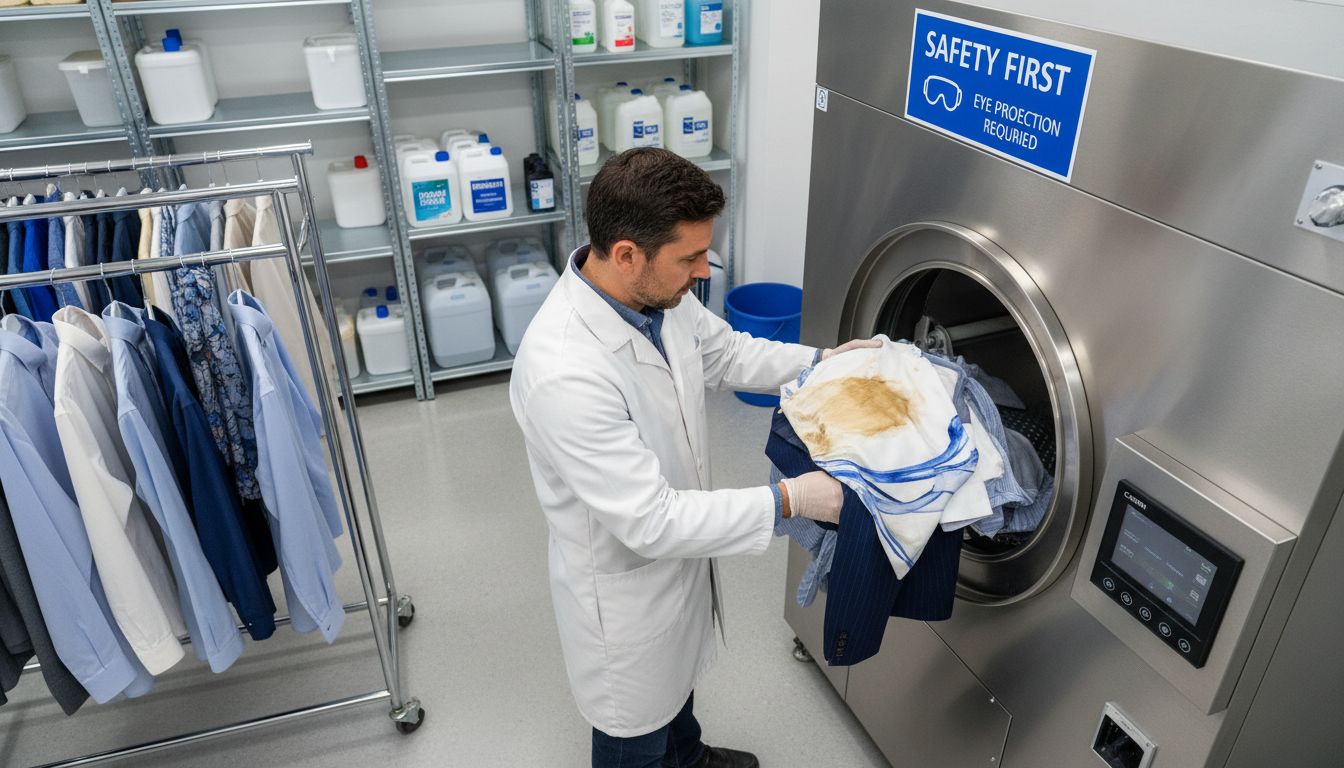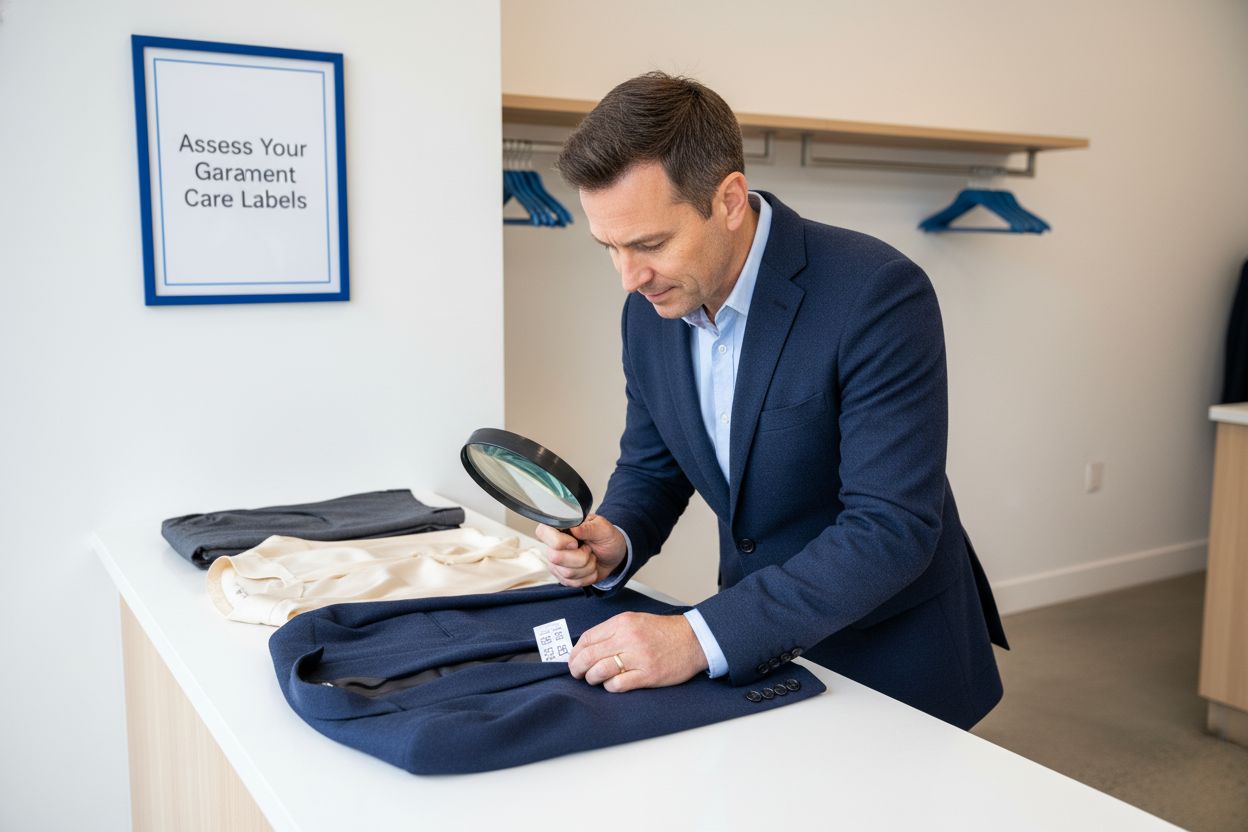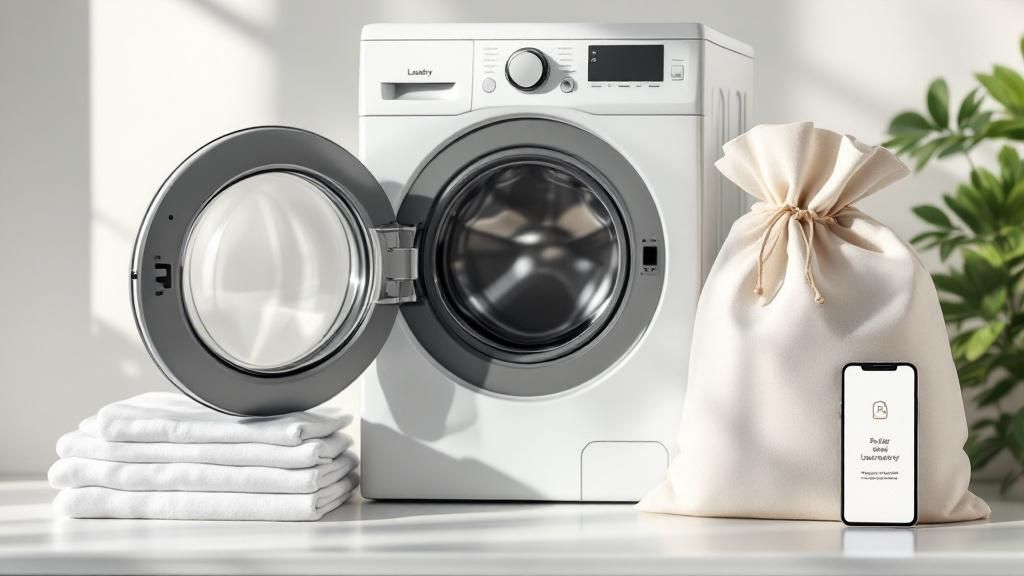What Is Dry Cleaning? Complete Expert Guide

Did you know that over 60 percent of delicate garments are damaged by home washing? The wrong cleaning method can turn silk into shrunken rags and bold colors into faded memories. Dry cleaning offers a solution that goes beyond stain removal, using advanced solvents to protect your most valued clothes. Discover how professional fabric care helps keep favorite outfits looking sharp and feeling new, while avoiding the pitfalls of regular washing.
Key Takeaways
| Point | Details |
|---|---|
| Purpose of Dry Cleaning | Dry cleaning uses specialized solvents to effectively clean delicate fabrics without the risk of shrinkage or color loss. |
| Types of Cleaning Methods | Primary methods include Perc cleaning, hydrocarbon cleaning, and eco-friendly alternatives like silicone-based and CO2 cleaning. |
| Process Overview | The dry cleaning process involves garment inspection, solvent cleaning, and drying, ensuring the preservation of fabric quality. |
| Cost and Risks | Dry cleaning can be more expensive than at-home methods, with potential health risks linked to chemical exposure; choose professional services for optimal care. |
Defining Dry Cleaning And Its Purpose
Dry cleaning is a specialized fabric cleaning process that uses non-aqueous solvents instead of traditional water-based washing methods. According to Occupational Safety and Health Administration research, this unique technique allows for comprehensive dirt and stain removal without risking fabric damage like shrinkage or color loss.
The primary purpose of dry cleaning is to safely clean delicate or complex garments that cannot withstand traditional washing. Specialized solvents penetrate fabric fibers more gently than water, effectively removing tough stains while preserving the fabric’s original texture, color, and structural integrity. Materials like silk, wool, cashmere, and structured items such as suits and formal wear particularly benefit from this cleaning approach.
Key advantages of dry cleaning include:
- Preservation of fabric quality
- Removal of stubborn stains water can’t eliminate
- Maintenance of garment shape and structure
- Extended clothing lifespan
- Professional treatment for delicate materials
By choosing professional dry cleaning services, you invest in maintaining the appearance and longevity of your most valuable clothing items, ensuring they remain crisp, clean, and looking like new.
Types Of Dry Cleaning Methods Explained
Dry cleaning isn’t a one-size-fits-all process. Different fabrics and stain types require specialized cleaning approaches. Solvent-based methods represent the primary techniques used by professional dry cleaners, each designed to tackle unique fabric challenges and maintain garment quality.
The two primary dry cleaning methods include:
- Perchloroethylene (Perc) Cleaning
- Most traditional method
- Highly effective for removing oil-based and tough stains
- Used extensively for suits, formal wear, and delicate fabrics
- Potential environmental concerns have reduced its popularity
- Hydrocarbon Solvent Cleaning
- More environmentally friendly alternative
- Gentler on fabrics
- Suitable for most clothing types
- Slower cleaning process compared to Perc
Emergent eco-friendly techniques are also gaining traction. Green dry cleaning methods like silicone-based solvents and CO2 cleaning provide sustainable alternatives that minimize chemical exposure while maintaining high cleaning standards. Learn more about professional dry cleaning processes to understand how these techniques preserve your most valuable garments.
Here’s an overview of common dry cleaning methods and their key features:
| Method | Main Solvent | Key Benefits | Potential Drawbacks |
|---|---|---|---|
| Perc Cleaning | Perchloroethylene | Strong stain removal Widely used |
Environmental concerns |
| Hydrocarbon Cleaning | Hydrocarbon solvent | Gentler on fabrics Less toxic |
Slower process |
| Silicone-Based Cleaning | Silicone | Eco-friendly Low odor |
Higher cost Less available |
| CO2 Cleaning | Liquid CO2 | Greenest option No chemical waste |
Requires specialized equipment |
Professional dry cleaners evaluate each garment’s fabric composition, color, and potential stains to determine the most appropriate cleaning method. This personalized approach ensures your clothing receives optimal care, extending its lifespan and maintaining its original appearance and quality.
Step-By-Step Dry Cleaning Process
According to the Centers for Disease Control and Prevention, the dry cleaning process is a precise, multi-stage technique designed to meticulously clean and preserve delicate garments. Professional dry cleaning transforms fabric care from a simple wash to a comprehensive restoration process.
The typical dry cleaning process unfolds through several critical stages:
- Garment Inspection and Pretreatment
- Detailed examination of fabric type and stains
- Identifying specific cleaning requirements
- Applying targeted stain removal treatments
- Marking garments for specialized handling
- Solvent Cleaning
- Immersing garments in specialized chemical solvents
- Thoroughly removing dirt, oils, and stubborn stains
- Gently cleaning fabrics without water-related risks
- Maintaining original fabric texture and color
- Solvent Extraction and Drying
- Spinning garments to remove excess solvent
- Tumbling in carefully controlled hot air streams
- Ensuring complete solvent removal
- Restoring garment shape and preventing shrinkage
Learn more about the detailed dry cleaning process to understand how professional techniques transform your most challenging cleaning needs. Each step is meticulously designed to protect your clothing, extend its lifespan, and return it looking pristine and refreshed.

Key Benefits And Ideal Use Cases
According to the Centers for Disease Control and Prevention, dry cleaning offers unique advantages for fabric care by using specialized solvents that protect clothing from water-related damage. Fabric preservation becomes a critical benefit for individuals seeking to maintain the quality and longevity of their most valued garments.
Ideal use cases for dry cleaning include:
-
Delicate Fabrics
- Silk
- Wool
- Cashmere
- Vintage clothing
- Intricate embellished garments
-
Professional Attire
- Suits
- Blazers
- Dress shirts
- Formal wear
- Business uniforms
Specialized Cleaning Benefits:
- Stain removal without water damage
- Fabric structure maintenance
- Color preservation
- Odor elimination
- Professional pressing and finishing
Discover more about professional stain removal techniques to understand how targeted cleaning methods can restore and protect your most challenging garments. Professional dry cleaning isn’t just cleaning—it’s a comprehensive fabric care strategy designed to extend the life and appearance of your clothing investments.
Costs, Limitations, And Common Risks
According to the Occupational Safety and Health Administration, dry cleaning involves potential health and environmental risks that consumers and professionals should carefully understand. Chemical exposure remains the primary concern, with traditional solvents potentially causing significant health complications if not handled professionally.
Cost Considerations:
- Average dry cleaning costs range from $3-$15 per item
- Specialized garments may cost more
- Bulk cleaning can reduce per-item expenses
- Professional services charge premium rates for complex fabrics
Potential Risks and Limitations:
- Chemical solvent exposure
- Potential fabric damage
- Color fading or bleeding
- Environmental concerns
- Higher costs compared to home washing
Health and Environmental Concerns:
- Perchloroethylene can cause central nervous system depression
- Potential long-term organ damage from repeated exposure
- Environmental contamination risks
- Some solvents contribute to air and water pollution
Learn more about professional dry cleaning safety standards to understand how modern cleaning services minimize these risks. Professional dry cleaners now increasingly adopt eco-friendly techniques to protect both your garments and the environment.
Dry Cleaning Versus At-Home Alternatives
According to the Cleaning Institute, at-home washing methods are not universally suitable for all garments. Fabric care requires a nuanced approach, with professional dry cleaning offering specialized treatment that home methods simply cannot match.
At-Home Washing Methods:
-
Machine Washing
- Quick and convenient
- Low cost
- Works for everyday fabrics
- Risk of shrinkage and color fading
-
Hand Washing
- Gentler than machine washing
- More time-consuming
- Limited effectiveness for deep cleaning
- Requires specific detergents
Comparison Criteria:
- Fabric Protection
- Stain Removal Effectiveness
- Time Investment
- Cost
- Preservation of Garment Quality
| Cleaning Method | Best For | Limitations |
|---|---|---|
| Dry Cleaning | Delicate fabrics, suits, formal wear | Higher cost, chemical exposure |
| Machine Washing | Everyday cotton, synthetic materials | Potential fabric damage, color loss |
| Hand Washing | Delicate items, wool, silk | Time-consuming, limited deep cleaning |
Explore our comprehensive household laundry service guide to understand how professional cleaning can extend the life of your most treasured garments. The right cleaning method isn’t just about removing dirt—it’s about preserving your clothing’s quality and appearance.
Keep Your Delicate Garments Fresh and Flawless with Expert Dry Cleaning
If you value the unmatched fabric care described in “What Is Dry Cleaning? Complete Expert Guide” you understand how important professional cleaning is for preserving delicate fabrics and extending the life of your favorite clothing. Dry cleaning protects your garments from shrinkage, color loss, and damage while removing stubborn stains with specialized solvents. However, managing these needs can be time-consuming and complicated.

At Columbia Pike Laundry, we specialize in handling all your dry cleaning needs with precision and care. Whether it is silk, wool, or your professional attire, our in-house experts use safe, advanced methods to keep your clothes looking pristine and fresh. Experience convenience through our easy online scheduling, trusted local service, and fast turnaround times that fit your busy life. Do not wait to protect your wardrobe from wear and tear—discover the full benefits of Dry Cleaning and Fabric Care Expertise by choosing Columbia Pike Laundry today. Visit us online at https://columbiapikelaundry.com to schedule your pickup or drop off your garments at 2602 Columbia Pike.
Frequently Asked Questions
What is dry cleaning and how does it work?
Dry cleaning is a cleaning process that utilizes non-aqueous solvents to clean fabrics instead of water. The process involves several stages including garment inspection, solvent cleaning, and drying, which together remove stains and preserve fabric quality without risking damage typically associated with water.
What types of fabrics benefit most from dry cleaning?
Delicate fabrics such as silk, wool, cashmere, and structured items like suits and formal wear are best suited for dry cleaning. This method effectively cleans without causing shrinkage, color fading, or damage to the fabric’s structure.
What are the benefits of using professional dry cleaning services?
Professional dry cleaning services offer several advantages, including the preservation of fabric quality, effective removal of stubborn stains, maintenance of garment shape, and the extension of clothing lifespan. It is especially effective for delicate and complex garments that require special care.
How does dry cleaning differ from at-home washing methods?
Dry cleaning is specifically designed for delicate or structured fabrics and uses specialized solvents for cleaning, while at-home washing methods can involve water and regular detergent, which may not be suitable for all garments. Dry cleaning helps prevent damage like shrinkage and color loss, making it a safer option for sensitive items.
Recommended
Popular Blog Articles

Meet the Author
Daniel Logan didn’t start CPL because he loved laundry. He started it because his family was drowning in time debt, and laundry was one of the biggest weights.
Mornings were chaos with two kids under 5. Evenings felt like catch-up. And weekends? Gone to sorting socks and folding piles.
He knew his story wasn’t unique. So he built a business that gave families like his just a little bit of breathing room one load at a time.
With no laundry experience but deep tech skills, Daniel rolled up his sleeves, doing every job himself while building systems that turned it into a modern laundry service that saves customers time, simplifies their lives, and delivers reliability they can count on.
That’s where CPL began. Not from a playbook, but from pain. From one dad trying to buy back time: for himself, and for every household like his.





